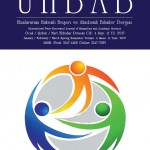RISK MANAGEMENT IN LIBRARIES, ARCHIVES AND MUSEUMS
Kuzucuoglu, Hamdi Alpaslan Risk Management in Libraries, Archives and Museums. IIB International Refereed Academic Social Sciences Journal, 2014, flight. 5, n. 15, pp. 277-294.
Abstract
Libraries, archives and museums around the globe are exposed to risks stemming from environmental conditions and human-driven potential hazards. Since an emergency/disaster immediately breaks out, the four key principles of disaster management, namely preparedness, damage reduction, intervention and improvement, should strictly be defined proactively, planned and necessary measures should be taken beforehand. In a well set-up Library, Archive ( information and documentation centers) and Museum Risk Management, it is important to define the hazards and prioritize them after the assessment of the risks that may be posed by such hazards. Again based on this management system, continuous improvement through Plan-Do-Check-Act (PDCA) cycles should be aimed. Risk analyses should be performed in consideration of the incidence frequency, severity and duration of emergency/ disasters; number of collection, library and archive items; number of workers; number of users; building characteristics (structural quality, quality of non-structural elements, geological condition of soil, etc.) as well as the properties of hazardous facilities surrounding the building. Separate strategies to control each risk originating from hazards (aimed at controlling the risks in the short, medium and long term) should be defined. In this study, the importance of risk analysis and risk assessment for Libraries, Archives and Museums under the Occupational Health and Safety Law no 6331 has been emphasized, and a sample risk analysis based on the 5×5 risk matrix method is presented.
Summary
Libraries all over the world, archives and museums, environmental conditions and human faces risks related to potential hazards induced. An emergency / If the disaster occurs suddenly because of disaster management preparedness of the four principles, harm reduction, The intervention and the rehabilitation stage with absolute pre-defined proactive methods, planning and measures must be taken of. A successful library, Archives (information and documentation centers) Risk Management and the Museum of danger it is important to prioritize defined after analyzing the risks arising from them. Planning again based on this management system, Application, Testing and Review (PUKO) It should aim at continuous improvement of cycle. Emergency / The frequency of occurrence of disasters, size, time, library, archives, The size of the museum building, collection, The number of library and archival materials, Number of employees, Number of users, building feature (build quality, The quality of the non-structural material, the state of the ground geologically and so on.), taking into account the characteristics of the dangerous plant risk analysis should be carried out around the building. In order to control risks arising from a separate strategy for each hazard (short, aimed at the medium and long term control of risks) to be determined. Working, Library, Archives and Museums in 6331 Occupational Health and Safety Act No. importance of the issues under evaluation and risk analysis of the risks highlighted, 5×5 risk matrix method applied by the suggestion of a risk analysis was presented.
Keywords: Cultural heritage risk management, risk analysis methods, risk monitoring, risk management, information and documentation management; cultural heritage risk management, risk analysis methods, risk monitoring, risk management, information and document management


